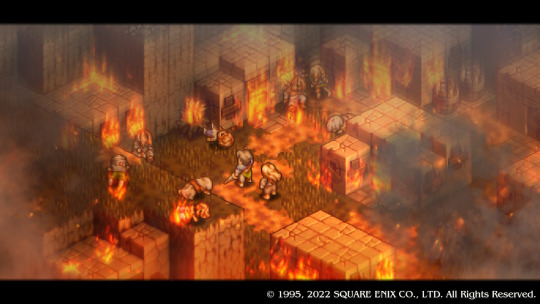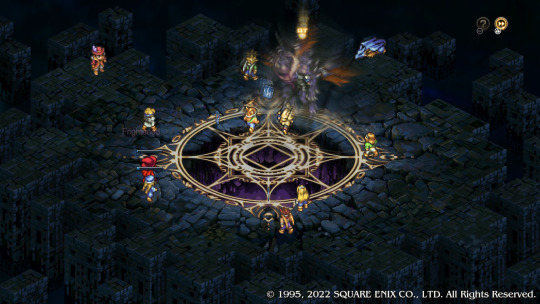#king dorgulua
Text
The Art of Decision-Making
Tactics Ogre is a game that first released in 1995. It saw a re-release on the PlayStation Portable (PSP) with a revamped title: Tactics Ogre: Let Us Cling Together before emerging once more to grace our consoles as Tactics Ogre Reborn. And as a fan of the Final Fantasy Tactics game, who also thoroughly enjoyed her time with Triangle Strategy, trying out the original inspiration behind these two games was a no-brainer. After all, strategy/ tactical role-playing games have always been able to present the conflicts of war in a both complex and engaging manner, especially when they allow for personal choices to influence the trajectory of where the story may go.

Of course, given this is a role-playing game from Japan, a supernatural element must be inserted. Along with a late-game reveal of the true antagonist. In Tactics Ogre, I was pulled a little from my enjoyment of the story when the initial focus was resolved and the final boss ended up being with a literal demon incarnation of the previous king.
True, they had sprinkled in some of King Dorgulua’s backstory with Catiua’s reveal but the war between the Gods and the Ogres (whilst present in the opening credits) was mentioned little throughout the game, what with its focus on the repercussions on war. So, the entire exposition with Dark Knights Barbas and Martym felt a little hamfisted in its attempt to introduce the big bad at the end of the game.
In a way, it also dismissed a lot of the earlier turmoil that took up the bulk of the game was insignificant as a God emerged from the depths to rule over the world. Especially as, even though you can have Catiua in your party, her relationship with King Dorgulua is never touched upon during that final battle.
Beyond these little titbits, as well as a few well-worn tropes of disguised royalty, I did still thoroughly enjoy the initial set-up of the game with Denam, Catiua and Vyce rebelling against Galgastan oppression on the Walisters. The internal fighting among the rebellion, the moral dilemma of whether or not to kill your own to drag unwilling participants into war and the underhanded tactics to install a ruler over the land of Valeria was a sight to behold.

In fact, it would have been the preference of this humble blogger if things had remained there with King Dorgulua’s name fading into the annals of history. Or if there had been renewed focus on the nations of Lodis or New Xenobia and what their stakes were when it came to meddling with Valerian affairs.
Given that the game came out back in 1995, though, it’s understandable for why the developers decided to go down the route they chose. Despite the questionable choice of ending boss battle, the game still holds up even today. I would have liked some additional context with the other Ogre Battles and the history of the world I found myself in (this entry being the seventh episode) but I was still able to follow along in terms of the general motivations of the core characters as well as the villains.
This was especially astounding when it came to the choices that Denam had to choose in key beats of the plot. The variations of choice, even dialogue options, had ramification for the ending. Not to mention the Chaos Frame mechanic that was hidden behind it all and could have led to other distasteful outcomes for our main protagonist.

The gameplay for Tactics Ogre is very similar to Final Fantasy Tactics. It includes hiring or recruiting generic fighters to the cause and using them in battle. Of course, there are also unique characters with their own special sprites. But in terms of the actual flow of battle, the unique characters added little. Although, some had special classes that added a little flavour to battles. It should be noted that for every major battle, only Denam, had to feature in them all. The other playable characters could be interchanged with little repercussions. Or dismissed if the need arose.
Just like Final Fantasy Tactics, the game featured an overworld map and when a battle was entered, it would zoom onto a particular map with a grid overlay. Characters can move, use skills and perform one action. The action could range from using spells, items or actually attacking another character. The key to Tactics Ogre’s battle system is not unlike the weapon triangle of Fire Emblem. However, it is switched to six elements. Those being fire, water, lightning, earth, air and ice.
There is also an unspoken counter system with mages being better placed to counter buffed frontline attackers, mages being vulnerable to ranged attacks from archers, and units with higher defence taking minimal damage from ranged weaponry. Something I only gradually picked up on later as I favoured charging in and trying to destroy everything as quickly as possible.
Mana, like Triangle Strategy, is a limited but rechargeable pool that is empty at the start of battle. This differs from Final Fantasy Tactics, which allowed mages to immediately start raining hellfire onto their foes from the very beginning. It allowed for more tactical positioning as I awaited for enough mana to unleash what spells I had equipped my magic users. Mana was also important for non-magic users too as they were key to using finishing moves that could deal out a ton of damage.
As such, there was a good strong focus on buffing up the magic reserves for all characters. The only downside to this, of course, was how few and far between such mana replenishing items were as they did not appear to be sold at shops and had to be found as drops from enemies or occasionally scrounged up from certain tiles on battle maps.
One important thing I noted when playing Tactics Ogre Reborn was the fact that items, spells and skills were limited. One could not deck out their favourite warriors with 99x of all items. Rather, they could equip four of each. This meant that item usage, spells and skills had to be considered for each encounter. While this led to a few annoying battles where I struggled against certain units (of note, beasts), it did add another layer of strategic thinking to an otherwise excellent game known for the tactics needed.
Especially as there was a level cap for my characters!

I was utterly devastated to learn that I could not simply overlevel all my characters to decimate the opposition. Rather, my characters were all limited by the ‘Union Level.’ This allowed battles to be even-playing fields and I couldn’t take advantage of better stats to stack the battlefield. A shame, I know, but I made up for it by exploiting crafting and ensuring that my army was well-armed and well-equipped for each battle I went into. If I hadn’t used the exploit and had played it as it was intended, I would have, no doubt, struggled a little more with the game with fewer resources at my disposal and having to better pick and choose the units I took into each battle.
Of course, such things could be counteracted by picking up buff cards that could allow me to deal more damage than my unit might have usually been able to deal out against a particular enemy. It was especially useful against the final boss.
Overall, I enjoyed my time with Tactics Ogre Reborn. While I would have preferred being able to overlevel my units so I didn’t have to fear losing against difficult bosses, it allowed me to think differently on how I engaged with tactical role-playing games. There was even some joy in it when it came to repurposing my units and swapping out abilities and spells when required to deal with a particular annoying foe that favoured certain status effects such as petrification or fear.
Most of all, what I loved most of Tactics Ogre Reborn was the world-building and the hidden layers within. Perhaps one of these days, I could find a way to play the other Ogre Battle games but for now, I am still quite satisfied with the complex world that was crafted to explore what it means to rebel against oppression and to dream of a fairer and better world.


#video games#tactics ogre reborn#tactical role-playing game#square enix#denam#catiua#king dorgulua#choices matter
5 notes
·
View notes